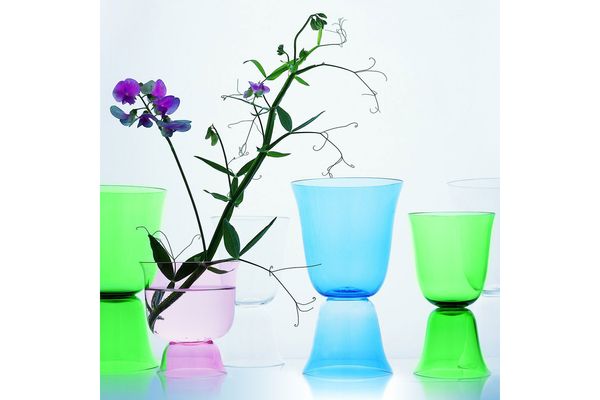
In the summer of 1999, I worked for a wise and lovely lady, who taught me many things and one day said, “Always spend more on flowers than on food. Good for the soul, better for the waistline.” I can’t pretend that I’ve always followed this sage advice — you can only spend so much on January carnations, but I took the spirit of it. Now, I think it’s good to have flowers around when you can afford them: Not just because they’re something living and beautiful, but because they die, too, and it’s not always a bad thing to be reminded of such things.
For those nonprofessionals of us who don’t really know how to arrange flowers properly (and I do think it’s a largely lost art), there are two basic approaches to making them look good: big and small. By “big,” I mean a bunch of bodega tulips stuffed into a large vessel. And small is getting the most bang for your buck: breaking up a bunch of freesia or carnations or whatever into as many small sprigs as possible, and placing them artfully around one’s home in the approved Instagram manner. So I went and found the best vases for doing just that (the arrangement, flowers and all, would be a terrific Mother’s Day present).
If you’re going for the wildflower, country-garden effect, what you want is a large ewer-esque pitcher. Especially good for blowsy, aging tulips and those bunches of weeds certain non-floral green-market vendors pass off as bouquets, and which I can never resist. If you covet a French provincial look, this pitcher here combines the double benefits of a jutting lip and a neck thin enough to keep the scraggliest stems in line.
To round out a vase collection — if you’ve got the room — I highly recommend getting one cylinder big and sturdy enough to hold branches. Something like this, although most any florist will have them. Keep in mind that although bringing branches home on the subway buys you a lot of enemies, a few go a long way, and they last literally for months, whether we’re talking forsythia, quince blossoms, magnolia, or pussy willow. (I’m not nuts about cherry blossoms because by the time you get them home, you’ve usually lost half the blooms.) The effect is very museum lobby-ish, in the best way.
As with many things, a large vase wardrobe doesn’t mean much actual variety: I find myself returning to a couple of vessels time and time again. Basically, for small arrangements, you want something with a narrow neck. Little apothecary bottles are good (if you happen to have a ready supply of old apothecary bottles), and so are the glass bud vases they sell at CB2 that have a kind of beaker vibe — good for past-their-prime ranunculus, and an easy centerpiece “running down” a table. (A note here on Mason jars. Obviously, do whatever you want, but as with most things, Mason jars are a slightly sad reminder of a more innocent time, and have the air, if not the fact, of a bow of raffia tied around them at a 2011 wedding.)
Unfortunately these are sold out, but here is a flat mini bud vase and here is another small but sturdy bud vase.
If you want to give someone a good wedding gift, may I suggest this beautiful Josef Hoffmann bell vase from the Neue Galerie? I was given one myself, and although it breaks the small-mouth rule, it’s squat enough that trimming just about any bunch of tulips or hyacinth will result in a lush effect. Remember to stick a penny in the bottom to help keep the water clear.
These come in a nice range of colors, and I find myself reaching for them a lot.
The Strategist is designed to surface the most useful, expert recommendations for things to buy across the vast e-commerce landscape. Some of our latest conquests include the best women’s jeans, rolling luggage, pillows for side sleepers, ultra-flattering pants, and bath towels. We update links when possible, but note that deals can expire and all prices are subject to change.
Every editorial product is independently selected. If you buy something through our links, New York may earn an affiliate commission.










